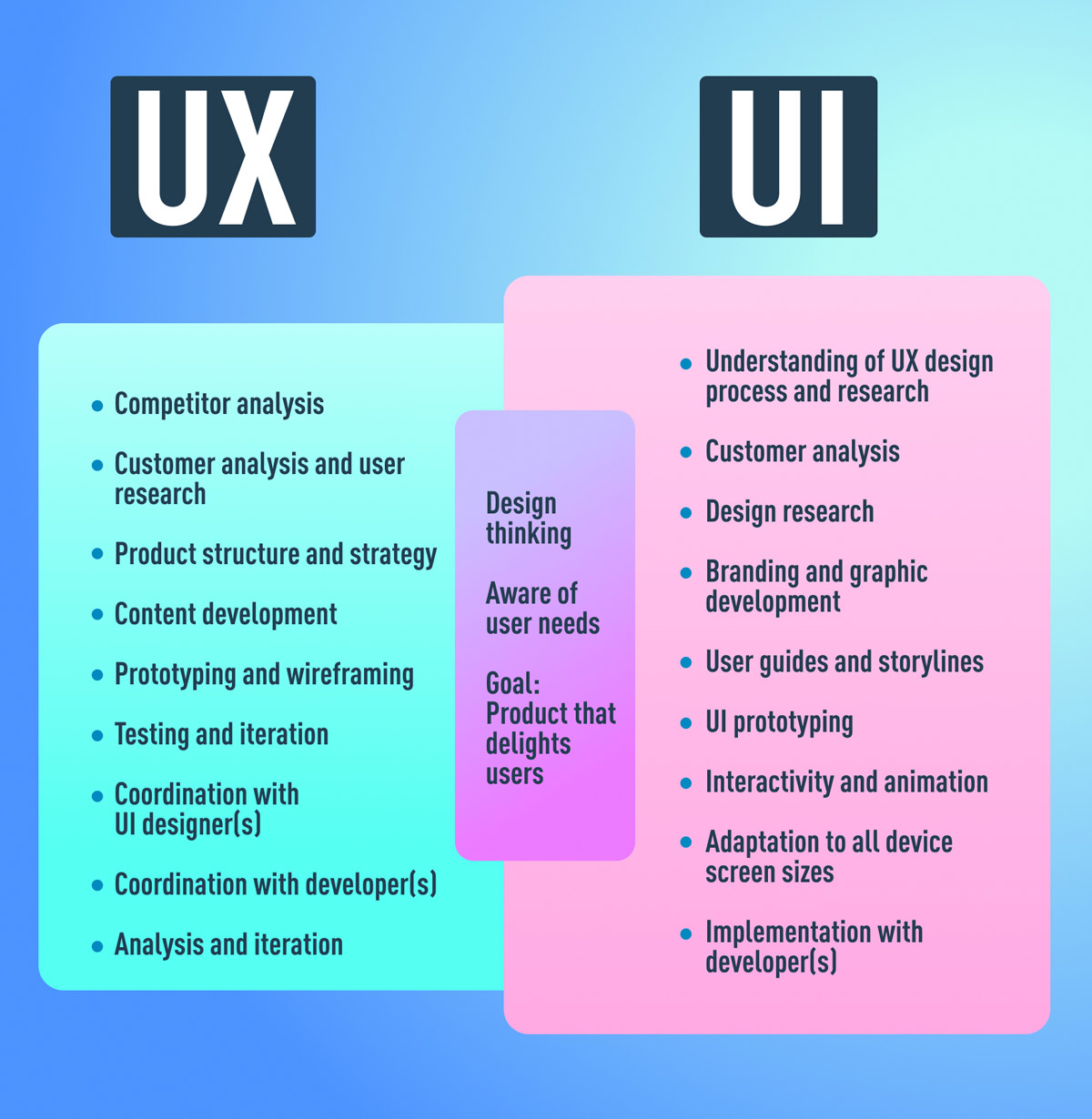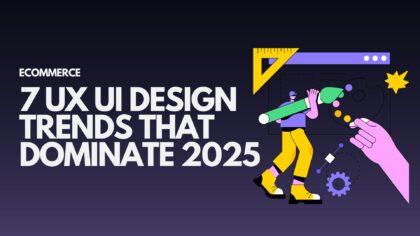UX and UI: Is often used interchangeably but means the same, but let us understand the minute difference between both the terms.
If you’re enthusiastic to learn what exactly UX and UI mean and how they differ, you’ve come to the right place. Below is a breakdown of what we’re going to cover in this article. Read how to become a UX designer or UI designer.
-
 What are UX and UI in the first place?
What are UX and UI in the first place?
- What is user experience (UX) design?
- What is user interface (UI) design?
- What’s the difference between UX and UI design?
- How do UX design and UI design work together?
- UX vs. UI design: Which career path is right for you?
- What are the key tasks and skills required of UX vs. UI designers?
- What does a UX designer do?
- What does a UI designer do?
- Which is better paid, UX or UI?
things first: What do UX and UI mean?
In simpler terms, UX design refers to the term “user experience design”, while UI stands for “user interface design”.
Both elements are crucial to a product and work closely together. But despite their professional relationship, the roles themselves are pretty different, leading to very different phases of the product development process and the design discipline.
Before we consider the key differences between UX and UI, let’s first define what each term means individually.
What is user experience (UX) design?
A UX designer thinks about how the experience makes the user feel, and how easy it is for the user to accomplish their desired tasks. They also observe and conduct task analyses to see how users complete tasks in a user flow.
For example: How easy is the checkout process when shopping online? How easy is it for you to grip that vegetable peeler? Does your online banking app make it easy for you to manage your money?
The ultimate purpose of UX design is to create easy, efficient, relevant, and all-around pleasant experiences for the user.
We’ll answer the question “What does a UX designer do?” in section four. For now, here’s what you need to know about UX design in a nutshell:
- User experience design is the process of developing and improving the quality of interaction between a user and all facets of a company.
- User experience design is, in theory, a non-digital (cognitive science) practice, but used and defined predominantly by digital industries.
- UX design is NOT about visuals; it focuses on the overall feel of the experience.
What is user interface (UI) design?
Despite it being an older and more practiced field, the question of “What is user interface design?” is difficult to answer because of its broad variety of misunderstandings. While user experience is a conglomeration of tasks focused on the optimization of a product for effective and enjoyable use, user interface design is its complement; the look and feel, the presentation and interactivity of a product.
But like UX, it is easily and often confused by the businesses that employ UI designers—to the extent that different job posts will often refer to the profession as completely different things.
If you look at job ads and job descriptions for user interface designers, you will mostly find interpretations of the profession that are akin to graphic design, sometimes extending also to branding design, and even frontend development.
So let’s set the record straight once and for all. Unlike UX, user interface design implies a strictly digital term. A user interface is the point of interaction between the user and a digital device or product—like the touchscreen on your smartphone, or the touchpad you use to select what kind of coffee you want from the coffee machine.
About websites and apps, UI design considers the appearance, feel, and interactivity of the product. It’s all about making sure that the user interface of a product is as intuitive as possible, and that means carefully considering every visual, interactive element the user might encounter.
A UI designer will think about icons and buttons, typography and color schemes, spacing, imagery, and responsive design.
As user experience design, user interface design is a multi-faceted and challenging task. It is responsible for the transference of a product’s development, research, content, and layout into an attractive, guiding, and responsive experience for users.
We’ll look at the UI design process and specific tasks that a UI designer can expect in section four. Before we consider the main differences between UX and UI, let’s quickly recap on what user interface (UI) design is all about:
- User interface design is a purely digital practice. It considers all the visual, interactive elements of a product interface—including buttons, icons, spacing, typography, color schemes, and responsive design.
- The goal of UI design is to visually guide the user through a product’s interface. It’s all about creating an intuitive practice that doesn’t require the user to think too much!
- UI design transfers the brand’s strengths and visual assets to a product’s interface, making sure the design is consistent, coherent, and aesthetically pleasant.
Now we have a clear-cut definition of both UX and UI, let’s consider the key differences between the two.
 What’s the difference between UX and UI design?
What’s the difference between UX and UI design?
The main difference to bear in mind is this: UX design is all about the overall feel of the experience, while UI design is all about how the product’s interfaces look and function.
A UX designer considers the user’s entire journey to solve a particular problem; what steps do they take? What tasks do they need to complete? How straightforward is the experience?
Much of their work focuses on finding out what kinds of problems and pain points users come up against, and how a certain product might solve them. They’ll conduct extensive user research to find out who the target users are and what their needs are about a certain product. They’ll then map out the user’s journey across a product, considering things like information architecture—i.e. How the content is organized and labeled across a product—and what kinds of features the user might need. Eventually, they’ll create wireframes that set out the bare-bones blueprints for the product.
With the support of the product planned out, the UI designer steps in to bring it to life. The UI designer considers all the visual aspects of the user’s journey, including all the individual screens and touchpoints that the user might encounter; think tapping a button, scrolling down a page, or swiping through an image gallery.
While the UX designer maps out the journey, the UI designer focuses on all the details that make this journey possible. That’s not to say that UI design is all about looks; UI designers have a huge impression on whether or not a product is accessible and inclusive. They’ll ask questions like “How can different color combinations be used to create contrast and enhance readability?” or “What color pairings cater to color blindness?” You can learn more about UI design for accessibility here.
Hopefully, you’re now starting to see how UX and UI design are indeed two very different things. To summarize:
- UX design is all about identifying and solving user problems; UI design is all about creating intuitive, aesthetically pleasing, interactive interfaces.
- UX design usually comes first in the product development process, followed by UI. The UX designer maps out the bare bones of the user journey; the UI designer then fills it in with visual and interactive elements.
- UX can apply to any kind of product, service, or experience; UI is specific to digital products and experiences.
- How do UX design and UI design work collectively?
We’ve examined the differences between UX and UI; now let’s take a look at how they work together. You might be wondering if one is more important than the other, but the reality is, they’re both crucial!
UI design is like the icing on the UX cake. Imagine you come up with an amazing idea for an app; something that’s missing from the market and could genuinely change people’s lives for the better. You hire a UX designer to conduct user research and help you figure out exactly what features your app should have, and how the entire user journey should be mapped out. Your app offers something that your target audience needs and wants; however, when they download it, they find that the text on each screen is barely legible. What’s more, the buttons are too close together; they keep hitting the wrong button by mistake! This is a classic case of bad UI destroying what would have been good UX.
On the flip side, have you ever come across a really beautiful website only to find that, beyond the mind-blowing animations and on-point color scheme, it’s a real pain to use? Good UI can never make up for bad UX; it’s like picking up a beautifully decorated cake that tastes awful when you bite into it.
So, when it comes to product design, UX and UI complement each other—and in today’s competitive market, getting both aspects right is an absolute must. Whether you choose to work as a UX designer or a UI designer, it’s useful to have an understanding of both; after all, you’ll inevitably be working together. This brings us to our next section…
- UX vs. UI design: Which career path is right for you?
While UX and UI design do go hand-in-hand, you don’t need to be a master of both. So which career path is best suited to you, UX or UI?
If we touch on the attributes that will predispose you to work successfully in each area. If you want to learn more about what UX and UI designers do on a day-to-day basis, keep reading.
What are the key tasks and skills required of UX vs. UI designers?
If you want to figure out which career path is right for you, it’s important to consider the key skills required by UX vs. UI designers, as well as the typical day-to-day tasks of each. In the following infographic, we’ve highlighted the main hard, soft, and transferable skills for both UX and UI designers. And, in the next sections, we’ll consider the main tasks and responsibilities.
 What does a UX designer do?
What does a UX designer do?
So we now know, in abstract terms, what the role of the UX designer entails—but how does this translate into everyday tasks? Here is a cliff notes example of a UX designer’s typical tasks and responsibilities. You’ll find a more detailed account of the UX design process in this guide.
Strategy and content:
- Competitor analysis
- Customer review and user research
- Product structure and strategy
- Content development
Wireframing and prototyping:
- Wireframing
- Prototyping
- Testing and iteration
- Development planning
Execution and analytics
- Coordination with UI designer(s)
- Coordination with the developer(s)
- Tracking goals and Integration
- Analysis and iteration
So part-marketer, part-designer, part-project manager; the UX role is difficult, challenging, and multi-faceted. The role of the UX designer varies hugely depending on the type of company they’re working in. You see that iteration of the product, as compared to analysis or testing is indeed mentioned twice, but in reality, you would put it in between every other item on the list. Ultimately, the aim is to connect business goals to user’s needs through a process of user and usability trial and refinement toward that which serves both sides of the relationship.
What does a UI designer do?
If you like the idea of creating awesome user experiences but see yourself as a more visual person, you may be more interested in UI design.
The look and feel of the product:
- Customer analysis
- Design research
- Branding and graphic development
- User guides and storylines
Responsiveness and interactivity:
- UI prototyping
- Interactivity and animation
- Adaptation to all device screen sizes
- Implementation with developer
As a visual and interactive designer, the UI role is crucial to any digital interface and, for customers, a key element to trusting a brand. While the brand itself is never solely the responsibility of the UI designer, its key to the product is.
You’ll also note the final point which states responsibility for “implementation” of the design with a developer. While this is generally how UI jobs have worked in the past, you should be aware that the lines are blurring, as the term “web designer” (essentially a UI designer who can code) is being replaced by the expertise of user interface designers. While UX does not need coding, UI is a role that, as time progresses, will rely on it as part of building interactive interfaces. We discuss whether designers should learn to code here.
Which is better paid, UX or UI?
Salaries are of course dictated by many factors, though primarily:
- Location
- Experience
- Industry
- Project/product type
On average you’ll find that UI and UX jobs have similar salary ranges across a startup in Mumbai and minor tech industries. You’ll find however that in tech industries outside the web and mobile fields (e.g. car companies, medical equipment manufacturers, etc) there are more and richer opportunities for UI designers, as the field is not only more established but has a more direct, business-driven application.
Why do companies often advertise UX/UI roles as one?
We’ve established that UX and UI design are two separate fields, so now you might be wondering: why is it that so many job ads ask for UX/UI designers in one?
The truth is, in the huge scheme of things, UX and UI are still relatively new fields—and, as already mentioned, they tend to be specific to the tech industry. Outside the worlds of design and tech, they’re not so widely understood, despite being incredibly important for business. While the business value of good design is increasingly recognized, there’s still a tendency for hiring managers and recruiters to assume that UX and UI are done by the same person—hence the catch-all job ads you’ve no doubt come across.
It’s not always a simple case of misunderstanding, though. Many companies will deliberately seek out versatile designers who can cover both UX and UI, or who at least have an understanding of UX or UI principles in addition to their main skillset.
UX vs. UI: How do you work out which is a better fit?
If you’re keen to pursue a career in design but still aren’t sure whether to focus on UX or UI, you’ll need to spend some time thinking about where your interests lie, as well as what you’re naturally good at. Both UX and UI design are highly collaborative, varied career paths, placing you right at the cutting edge of technology and innovation. With that said, there are some key differences between the nature of the work and the skills required.
Why not try out this quick flowchart to get an idea of what path might be the best fit for you?

A career in UI also requires an understanding of user experience principles, but it’s much more focused on the visual, interactive aspects of design. If you’ve got a sharp eye for aesthetics and like the idea of making technology beautiful, user-friendly, and accessible, you might be more suited to a career in UI. Of course, if you like the idea of a career that combines both, there’s nothing to stop you from becoming a design all-rounder!
How do you learn UX and UI design skills?
While there are collegiate institutions that offer interactive design and visual design programs, there are very few official ways to learn either UI or UX Design skills as applied to working within tech startups, or even larger corporates.
If you live in a major metropolitan area, you may be lucky to have access to a variety of Bootcamp or class-style programs, such as General Assembly, or localized programs hosted by Google and other tech giants.
Online and with flexibility, you’ll find an unlimited range of free content and courses for both skills.
Lastly, I feel it is important to stimulate conversation. I am hoping that some of you lovely readers disagree with me and that you will voice it publicly by getting in touch with us or publishing a response. If our industry is confused, it is our job to un-confuse it, and the more passionate professionals that step up and contribute to the definition, the better.
- Wrap-up and further reading
Hopefully, this post has gone some way to clearing up the long-standing confusion around UX and UI. What we’ve covered today is just the tip of the iceberg; there’s a lot more to both UX and UI, so it’s worth reading up on each field in-depth to get a feel for what they entail and a deeper understanding of how they differ.
If you’re keen to learn more, check out these articles:
- A day in the life of a UX designer
- How to be a better UX designer in 2020
- Which are the best UX design certification programs?
- Will voice technology eventually replace screens?
And if you’re clear on the difference between UX and UI, and want to add a third term to your knowledge base:
- What is CX?
- UX vs. CX: What’s the difference?
Content Credit – https://careerfoundry.com/en/blog/ux-design/the-difference-between-ux-and-ui-design-a-laymans-guide/
 What’s the difference between UX and UI design?
What’s the difference between UX and UI design? What does a UX designer do?
What does a UX designer do?

